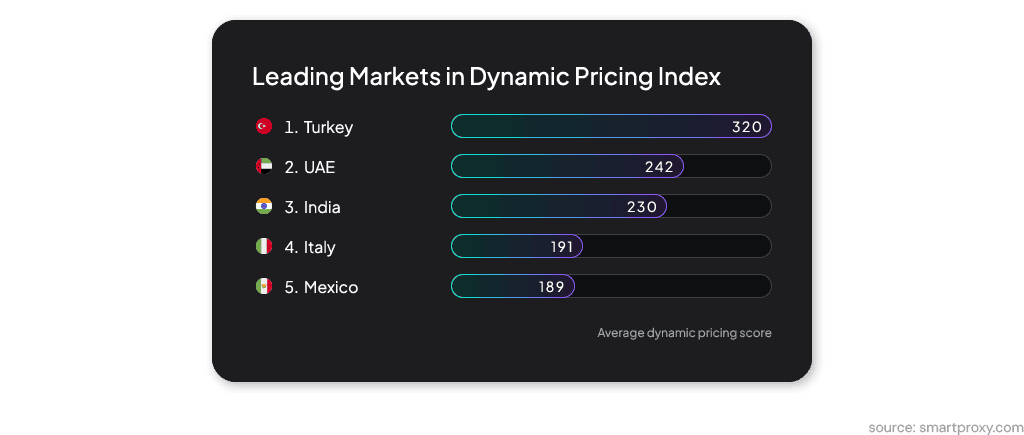Turkey, UAE, and India: Dynamic Pricing Leaders
Dynamic pricing, a strategy where prices of products or services are adjusted in real-time based on demand, supply, competitor pricing, and other factors, has become a popular practice in modern-day eCommerce.
Our recently published Dynamic Pricing Index dives deeper into the global landscape of this practice, revealing some intriguing trends. Interestingly, the leading countries in dynamic pricing are not from the traditionally dominant markets of Europe or North America but from the Asian continent. Turkey, the United Arab Emirates (UAE), and India have emerged as the top practitioners of dynamic pricing, with scores well above the global average.
Turkey leading the dynamic pricing
Turkey’s eCommerce sector demonstrates the highest proportion of dynamic pricing usage among the explored nations. This likely involves advanced algorithms that consider numerous variables to optimize prices continuously. Additionally, Turkey's dynamic pricing practices are marked by frequent price adjustments, allowing swift responses to market fluctuations and consumer behavior.
Several factors contribute to Turkey's progress in dynamic pricing. The country’s technological infrastructure supports the implementation of advanced pricing algorithms. Also, the competitive eCommerce market in Turkey drives companies to adopt innovative pricing strategies to gain an edge. This competitive pressure has led to a culture of agility and responsiveness in pricing, one of the most critical components of effective dynamic pricing.
United Arab Emirates show high frequency and high complexity
The UAE ranks second in dynamic pricing practices, distinguishing itself through its pricing models' high frequency and complexity. While the proportion of dynamic pricing usage is slightly lower compared to Turkey, the UAE compensates with an aggressive approach to price adjustments.
The eCommerce platforms in the United Arab Emirates frequently change their prices, ensuring they remain competitive and can capitalize on real-time market opportunities. Pricing strategies are supported by UAE’s strong economic framework and investment in digital infrastructure. The nation’s commitment to becoming a global eCommerce hub is evident in its adoption of cutting-edge technologies – retailers in the UAE utilize sophisticated software that can analyze large amounts of data in mere seconds, enabling frequent and precise pricing adjustments. This strategy is particularly beneficial in a market known for its diverse and international customer base, allowing businesses to effectively tailor their pricing strategies to different consumer segments.
India leveraging volume and complexity
India, ranking third in the Dynamic Pricing Index, presents a unique case. The country showcases a high level of pricing model complexity and frequent price changes, although the overall proportion of dynamic pricing usage is lower than in Turkey. India’s vast and diverse market requires complex algorithms to manage pricing effectively across various regions and consumer segments.
The Indian eCommerce sector is characterized by a high volume of transactions, which provides a rich dataset for dynamic pricing algorithms to learn and adapt. The frequent price adjustments in Indian eCommerce indicate a dynamic and highly competitive market environment.
Retailers in India are increasingly relying on advanced analytics and machine learning to refine their pricing strategies. This allows them to cater to a wide range of consumers, from budget-conscious shoppers to premium buyers, enhancing their market reach and profitability.

The importance of dynamic pricing
The dominance of Turkey, the UAE, and India in the Dynamic Pricing Index highlights the strategic importance of this practice in the eCommerce landscape. Dynamic pricing enables retailers to maximize revenue, improve inventory management, and enhance customer satisfaction by offering prices that reflect real-time market conditions.
For consumers, dynamic pricing can mean better deals and more competitive prices. However, it also requires them to be savvy and do appropriate market research before buying the product to avoid overpaying.
The high scores of these countries in the Dynamic Pricing Index directly translate into their commitment to innovation and technological advancement in the highly competitive landscape. As dynamic pricing becomes increasingly integral to the global eCommerce landscape, other countries may look to Turkey, the UAE, and India for best practices and inspiration.
Conclusion
Turkey, the UAE, and India are prime examples of how the right technological infrastructure and strategic approach can lead to excellence in dynamic pricing and its numerous benefits.
As the eCommerce sector continues to evolve, the practices observed in these leading nations will likely influence global trends, driving further innovation and efficiency in dynamic pricing strategies.
Learn more about dynamic pricing strategies by exploring eCommerce Maturity Index.
About the author

Dominykas Niaura
Technical Copywriter
Dominykas brings a unique blend of philosophical insight and technical expertise to his writing. Starting his career as a film critic and music industry copywriter, he's now an expert in making complex proxy and web scraping concepts accessible to everyone.
Connect with Dominykas via LinkedIn
All information on Smartproxy Blog is provided on an as is basis and for informational purposes only. We make no representation and disclaim all liability with respect to your use of any information contained on Smartproxy Blog or any third-party websites that may belinked therein.







